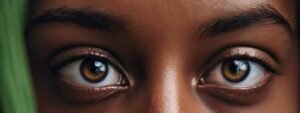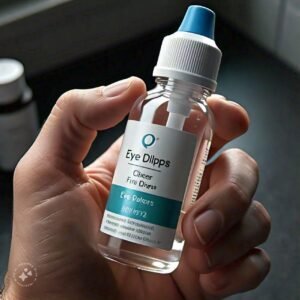Dry Eyes?
Dry eyes, sometimes referred to as dry eye syndrome, is a common disorder marked by irregular tear composition or insufficient tear production.
Dry eyes may arise if your tears are of low quality or not produced in sufficient amounts. The instability of tears causes inflammation and surface damage to the eye.
It can cause discomfort, impair vision, and raise the risk of eye infections.
Pathogenesis Mechanism:
A complex web of interrelated factors contributes to the pathophysiology of dry eyes, including: Insufficient tear production, instability in the tear film, abnormal tear composition, increased evaporation, and inflammation.
Reasons:
Environmental elements (wind, dry air, smoke)
Allergic eye disease
Aging
Using a computer and screen time
Wearing contact lenses
Taking some medications (antidepressants, antihistamines)
Health issues Autoimmune diseases (such as rheumatoid arthritis and diabetes)
Menopause and other hormonal shifts
Prolonged Screen Time and Dry Eyes:
With the rising use of digital gadgets in daily life, prolonged screen time has emerged as a major factor in dry eyes in recent years.

Screen time’s effects include:
Staring at computers, cellphones, and other digital devices for prolonged periods of time can induce dry eyes for the following reasons:
1. Decreased Blinking: Increased focus on a single point. When we concentrate on screens, we tend to blink less frequently, which lowers tear production and causes dryness.
2. Increased Blue Light Exposure: The blue light emitted by digital gadgets has the potential to cause dry eyes and increase tear evaporation.
3. Bad Viewing Habits: Improper viewing angles, distances, and postures can exacerbate dry eyes and eye strain.
Signs and Symptoms:
-Sensitivity to light
-Eye redness
-A sensation of having something in your eyes
-Difficulty wearing contact lenses
-Difficulty with nighttime driving
-Watering of eyes, body’s response to the irritation of dry eyes
– Redness
– Blurred vision
– Burning or stinging
– Increased sensitivity to light
– Eye tiredness

Medication:
There are various methods for treating dry eyes:
Numerous Options
Artificial Tears: Designed to supplement the body’s natural tear production, these can provide brief comfort.
Eye Ointments and Drops: A variety of formulations are available, ranging from lubricating drops to more potent ointments meant for use at night.
Prescription Drugs
Physicians may recommend corticosteroids or anti-inflammatory meds to reduce pain and inflammation.
Particular Eye Drops: Prescription eye drops often contain anti-inflammatory medications as well as other particular chemicals.
Lifestyle & Do-At-Home Remedies
Warm compresses
Eat lots of fruits and vegetables
Blink more
Hydration and Diet: Drinking enough of water and consuming omega-3 fatty acids can help preserve eye health.
Environmental Modifications:
Using a humidifier and avoiding direct airflow from fans or air conditioners will assist maintain moisture levels.
Supplements containing omega-3

Risk Factors for Dry Eyes:
The following are some of the factors that increase your risk of developing dry eyes:
Being more than fifty years old. As you age, you tend to produce fewer tears. People over 50 are more likely to have dry eyes.
Women are more likely to develop dry eyes, particularly if they are pregnant, taking birth control, or going through menopause, which might alter their hormones.
A diet deficient in omega-3 fatty acids, which are present in fish, walnuts, and vegetable oils, or vitamin A, which is present in liver, carrots, and broccoli.
Previous refractive surgery or wearing contact lenses.
What if Dry Eyes are not treated ?
– Elevated risk of corneal ulcers and eye infections
– Diminished vision
– Persistent otitis media
Preventative Actions:
Use Sunglasses and protective shields when necessary
Use Humidifier
While using screens adhere to the 20-20-20 rule, which states to look 20 feet away for 20 seconds every 20 minutes.
Modify the display’s brightness and contrast.
Place the computer or other device straight in front of you, Blink frequently
Use artificial tears
Avoid rubbing your eyes
Stay hydrated
The Impact of Dry Eyes on Life Quality
Dry eyes can interfere with a number of daily activities:
Effect on Day-to-Day Activities
Problems at Work:
Staring at a computer screen can make dry eyes worse, which makes it harder to work efficiently and requires frequent breaks.
Recreational and Social Activities: Reading, watching TV, and going to the movies are examples of activities that might lose their appeal or even cause discomfort.

Effects on Emotion and Psychology
Stress and Anxiety: Prolonged discomfort can exacerbate stress and anxiety, which can make going about everyday duties seem impossible.
Diminished Self-Esteem: Outward signs such as redness or tears might impact confidence and one’s perception of oneself.
Physical Unease
Pain and Irritation: Prolonged dryness of the eyes can cause pain and a grit-like feeling.
Effect on Sleep: The discomfort could make it difficult for you to go asleep or stay asleep, which would affect overall rest.

